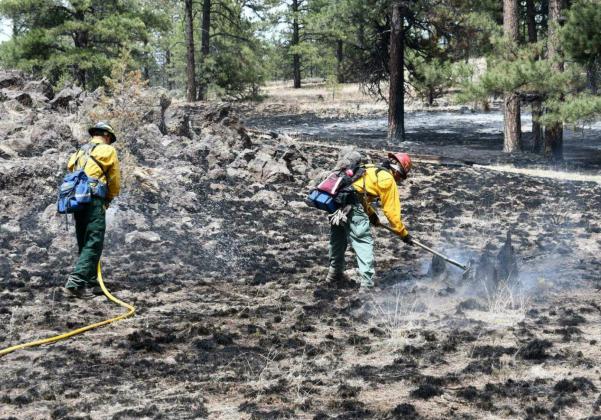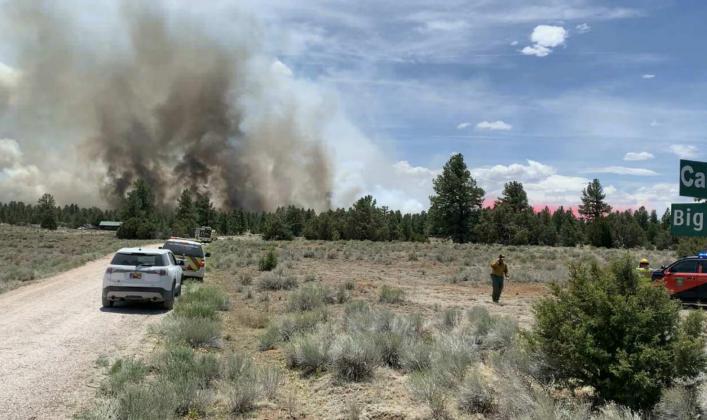Evacuations Ordered, Homes Destroyed
ZUNI MOUNTAINS, N.M. –
A fire started around 10:40 a.m. on June 9, the fire grew rapidly, destroying structures and creating evacuees out of Cibola residents. At 3:50 p.m. the fire was 100 acres, by 9 p.m. it had ballooned to 300 acres. Fire crews battled the fire all night, with Fire Marshal Dustin Middleton saying he only managed three hours of sleep that night. Officially named the Cerro Bandera Fire, the Cibola Citizen initially called this fire, the “Caldera Fire,” because Caldera Road was the first area to be evacuated. The fire was officially named in the afternoon of June 9. The American Red
The American Red Cross was called in, they assisted evacuees. Residents of Cibola rose when called upon, donations poured into the Red Cross evacuation shelter at the 515 W. High Street Old County Building – so many, that the Red Cross had to ask residents to stop bringing supplies for the moment.
Fighting the Fire It took several hours,
It took several hours, and hundreds of fireghters to battle the flames at the Cerro Bandera fire just to hold it and stop the spread.
June 9 – Daytime
At 10:40 a.m. in the Zuni Mountains, nestled delicately between the famous Ice Caves and the historic El Morro National Monument, a fire erupted. The cause has not yet been determined. The small fire was quickly reported, fire crews responded as quickly as they could. As Cibola County Fire Marshal Dustin Middleton was arriving on scene from the City of Grants, N.M., the fire has grown to 10 acres. By 1:25 p.m., the fire has grown in size and was an unconfirmed “20+” acres.
Evacuations were ordered immediately. Caldera Road and Big Pines Road were set on GO status, and evacuated. The Cibola County Sheriff’s Office came out in force to lend their help to evacuees and make sure everyone could get out safely, while providing a perimeter for the firefighting officials. The Ice Caves and surrounding areas, and the Cibola Trails subdivision were placed on SET status.
At 2:13 p.m., the fire was growing rapidly and the Cibola Trails Subdivision was placed on GO status, it was evacuated. An alert went out to Cibola County residents to expect significant air traffic, as the aircraft with water tankers were expected to be flying overhead. At 3:28 p.m. official word was released that the Ice Caves area, including Plume Road and other surrounding areas, were on GO status, they were evacuated.
Three aircraft capable of carrying water tankers were called in, and with their help water and flame retardant were dropped on the fire. By 4:30 p.m., six more water tankers were flying into Cibola to help. At 5 p.m., three structures were confirmed burned.
The sun began to set around 9 p.m., and Fire Marshal Middleton said the fire had grown to 300 acres. Four structures were confirmed lost to the flames, and a Type 3 Incident Management Team was being called in to support the firefighting efforts. Nearly 300 firefighters were on the scene of this fire.
Before flames had the opportunity to spread further, fire crews used the flame retardant to form a barrier around the 300- acre fire, hoping to prevent its spread through the night.
To help prevent other potential fire spread, Continental Divide Electric Cooperative disrupted power to about 60 homes in areas around the fire. There was a large power outage which effected Bluewater, Milan, and San Mateo, which was not connected to the fire. June 9 – Night
Fire activity slowed down as the moon rose. Firefighters worked tirelessly to create a barrier that would stunt fire growth.
Fire lines were established and by 1 a.m. fire crews were able to take a short break. The fire did not jump the fire lines, and was unsuccessful in trying to spread over the night as vigilant firefighters watched for hotspots. Aircraft carrying flame retardant dropped around the fire to create a barrier, in hopes of preventing further fire spread.
Fire Marshal Middleton said he only managed to sleep for three hours. June 10 – Day
6 a.m. came around as the sun began to rise, and good news followed. The fire was contained to 300 acres overnight, four structures were confirmed lost by this point and a Type 3 Incident Management Team was expected to arrive around 9 a.m.
The barrier established by aircraft held overnight, but it would not keep the fire at bay.
By 12 noon, the Type 3 Incident Management Team was being briefed on the situation of the fire as Cibola County Sheriff’s Deputies kept roads closed. The command team took control of the fire and more details began to be released from the scene of the fire.
Dry grass was a huge fire spreader. Dry grass, combined with the topography (changes in elevation) and numerous dead trees – killed by the infamous bark beetles of Cibola County – were identified as the largest source of a fuel for the fire.
“About 200” fire fighting personnel were on the ground, according to NM Fire Info’s Wendy Mason, who was the state’s contact person for information on the Cerro Bandera Fire.
By 4:40 p.m., the fire had grown to a staggering 939 acres with zero percent containment.
To get a better idea of the fire, and how to best tackle the flames, fire crews scheduled an infrared flight for that night. June 11
An infrared flight revealed that the fire was held up at 939 acres, it identified the hottest points of the fire, and gave fire crews an idea as to which direction the fire was spreading.
With this information in hand, firefighters went straight to work, bolstering defenses and making sure that the fire could not spread further. Their efforts were aided by a few minutes of light rain across the county.
By 10:29 p.m., fire crews had contained 25 percent of the fire, and had stopped all forward growth of the fire by hitting hot spots that had the opportunity to spread further. CDEC returned power to houses affected by the temporary pause in services that was done to help prevent further fire spread.
June 12 With power returned to residencies, multiple roads opened to the public once again, and firefighters continued their hard work at combatting the flames.
Significant progress was made in combatting the Cerro Bandera Fire this day. With fire crews using hand tools and hard work, the fire’s flanks were strengthened to prevent fire spread and crews contained 85 percent of the fire. June 13
The fire remained at 939 acres with 85% containment overnight. There was no fire growth.
Little news came out of the fire area on June 13, until an update near 9:50 p.m. declared the fire was 95 percent contained and residents could return to their homes.
Some roads may still be shutdown near the fire area. Please comply with orders by fire personnel if you come across these closed roads.
Fire crews spent the day eliminating the last of the hot spots, and the community was informed that there would be no more official updates on the fire as it was expected to be completely contained by end of day Tuesday, June 14.
Cerro Bandera Fire’s Cost
According to a preliminary report by the National Interagency Coordination Center’s Incident Management Situation Report, the Cerro Bandera Fire has cost $1.4 million as of June 13.
At least 200 firefighters all together were involved in combatting the flames and working to protect residencies. At least eight aircraft were involved in helping to combat the flames.
To prevent further fires in Cibola County and stop another huge hit to taxpayers, there are burn bans in effect. It is illegal to openly burn in Cibola County. Many fireworks are currently banned in the City of Grants.
Be smart about fire danger. With the Independence Day holiday rapidly approaching, make sure to take cautionary measures to prevent fire growth, whether lighting legal small fireworks or not.


